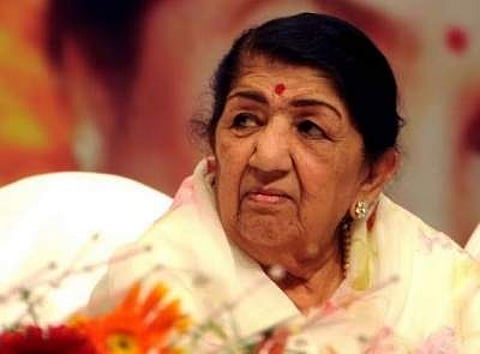
- LIFESTYLE
- FASHION
- FOOD
- ENTERTAINMENT
- EVENTS
- CULTURE
- VIDEOS
- WEB STORIES
- GALLERIES
- GADGETS
- CAR & BIKE
- SOCIETY
- TRAVEL
- NORTH EAST
- INDULGE CONNECT

The 92-year-old Lata Mangeshkar, India's most loved singer who passed away on Sunday after battling COVID-19 over the past few days, had once moved Pandit Jawaharlal Nehru to tears with her singing. Fondly called Lata didi, the Nightingale of Hindi cinema had also composed music for Marathi films and was a producer as well.
She was a recipient of three National Film Awards, seven Filmfare awards, and was awarded the Dadasaheb Phalke Award in 1989. She was conferred the Bharat Ratna in 2001, becoming the second singer after M.S. Subbulakshmi to be so honoured, and the French awarded her the Officer of the Legion of Honour. In 1974, Lata Mangeshkar became the first Indian to perform at the Royal Albert Hall, London. She had indeed come a long, long way since the time when the first song that she recorded for a film -- 'Kiti Hasaal' in 1942 -- was dropped in the final cut. Here's a look back at her journey, her beginnings and how she became one of the most loved singers not just in India but across the globe.
Born in what was then the princely state of Indore on September 28, 1929, to the classical singer, Marathi theatre actor and writer of musical plays Deenanath Mangeshkar and his wife Shevanti (Shudhamati), Lata Mangeshkar was originally named Hema by her parents, but they later changed it to Lata after the character Latika from one of her father's musical plays.
Lata Mangeshkar's association with the performing arts began when she was five and started appearing in her father's musical plays, and it continued even after her father's premature death in 1942, thanks to his good friend, the actor and director Master Vinayak (Vinayak Damodar Karnataki), who took the family under his wings.
It was Master Vinayak who took Lata Mangeshkar to Mumbai, paved her way into the world of Marathi cinema, got her to take Hindustani classical music lessons from Ustad Aman Ali Khan of the Bhendi Bazaar Gharana, and introduced her to Vasant Desai, V. Shantaram's favourite music composer.
But it was not until Master Vinayak's death in 1948 that the struggling singer-actor found the person whom she considered to be her "godfather" -- the music composer Ghulam Haider, who gave Lata Mangeshkar her first big break with the song 'Dil Mera Toda, Mujhe Kahin Ka Na Chhora' in the movie 'Majboor' (1948). It was her first big break.
Haider took his protege to Shashadhar Mukherjee, the Filmistan boss now better known as Kajol and Rani Mukherjee's grandfather, for his film, 'Shaheed' (1948), but he turned her down because he found her voice to be too frail.
Lata Mangeshkar proved him wrong just a year later when her song 'Aayega Aanewaala', filmed on the gorgeous Madhubala in Kamal Amrohi's debut directorial, 'Mahal' (1949), became an ageless hit.
Since 'Mahal', Lata Mangeshkar worked with several established music directors -- from Anil Biswas to S.D. Burman (and his son Rahul Dev, whose first and last song she sang), Naushad (who had asked her to sing like the then reigning nightingale, Noorjehan), Madan Mohan, Shankar-Jaikishan, Laxmikant-Pyarelal (for whom she's said to have sung 700 songs in 35 years), and Kalyanji-Anandji.
And she worked with every contemporary composer of note -- from Anand-Milind, sons of Chitragupt, with whom she had also worked, and Anu Malik, Sardar Malik's son, to Ilaiyaraaja and A.R. Rahman. It is said she worked with music directors from 13 states in her star-studded career.
After Noorjehan moved to Pakistan, Lata Mangeshkar became the go-to playback singer for every film producer and music composer. She did not disappoint them.
Lata Mangeshkar lent her voice to an endless succession of chart-topping numbers in Hindi cinema, from 'Allah Tero Naam' and 'Rangeela Re' to the 'Satyam Shivam Sundaram' title track, to 'Lukka Chuppi' in 'Rang De Basanti', apart from songs in Marathi (she also composed the music for several Marathi films in her 'Anandghan' avatar), Bengali, Tamil, Kannada, Malayalam, and Sinhala. 'Bellane Belagayitho' is the only Kannada song sung by her in the movie Krantiveera Sangolli Rayanna that was released in 1967. The film is also memorable because all three Mangeshkar sisters - Latha, Asha and Usha - lent their voices to songs in it.
In 1974, the Guinness Book of Records listed Lata Mangeshkar as the most recorded artiste in human history, stating that she had recorded "not less than 25,000 solo, duet and chorus backed songs in 20 Indian languages" between 1948 and 1974. The claim was contested by her long-time rival, Mohammad Rafi, who claimed to have sung around 28,000 songs.
After Rafi's death, the Guinness Book in its 1984 edition listed Lata Mangeshkar in its entry for 'Most Recordings', but it also recorded Rafi's claim. Later editions of the Guinness Book said Lata Mangeshkar had sung no less than 30,000 songs from 1948 to 1987.
She sang for 73 years, from 1943 to 2015, when she recorded her last song for a film (the Indo-Norwegian production, 'Dunno Y2...Life Is A Moment', which was all about gay love). Lata Mangeshkar commanded a fan following and an inimitable reputation with not many parallels in the Indian performing arts.
The late Yash Chopra, who was one of Lata Mangeshkar's favourite directors, said in an article he had penned for BBC.com on the occasion of the singer's 75th birthday (not long after she had sung the famous 'Veer Zaara' song, 'Tere Liye Hum Hain Jiye', with Roop Kumar Rathod): "I see God's blessing in her voice."